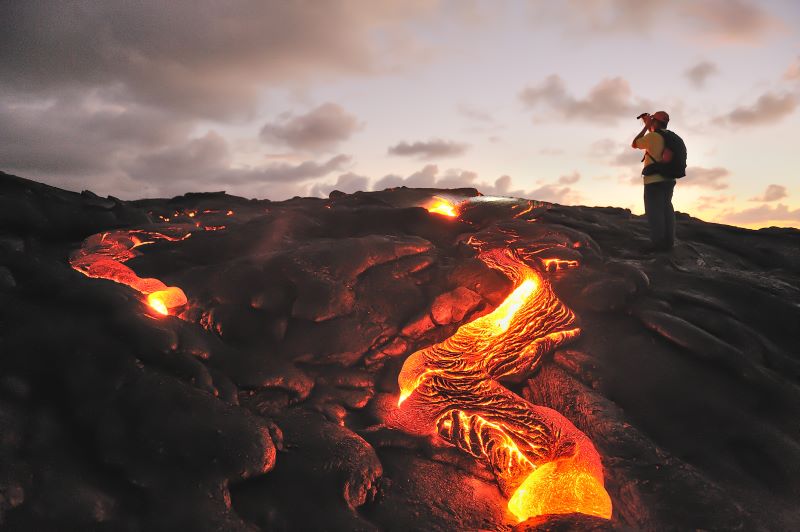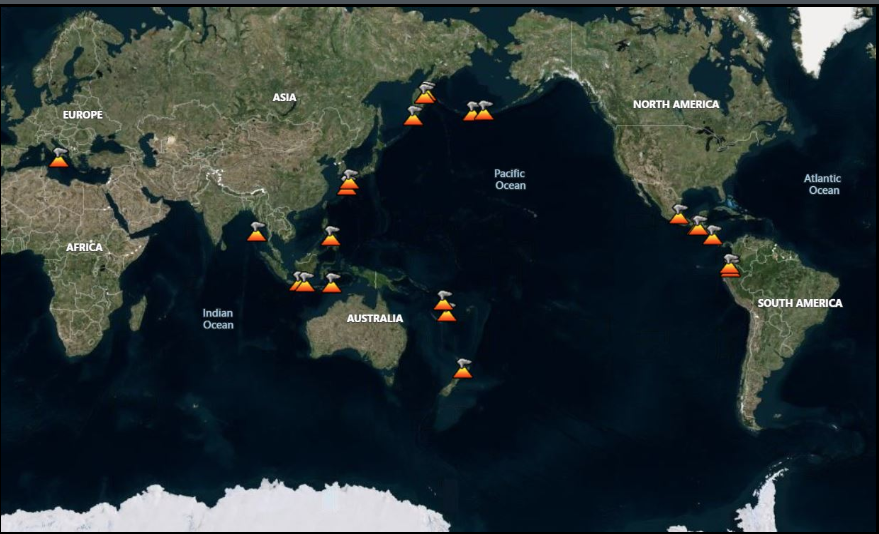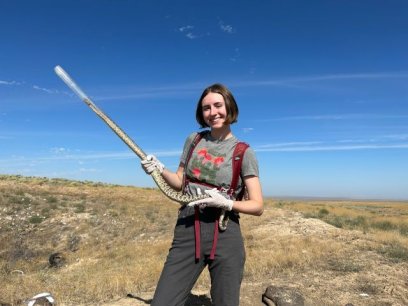
In September 2021, Kīlauea Volcano came roaring back to life at Hawai'i Volcanoes National Park. The youngest and most active of Hawaii's volcanoes has been erupting ever since. You can see the glow of Kīlauea's lava lake for yourself by viewing the US Geological Survey's live webcams.
Volcanoes are an important part of Hawaii's past and present. According to Native Hawaiian tradition, lava is the manifestation of Pele, the volcanic deity and creator of new lands. When Kīlauea erupted in 2018, lava flows reached the ocean and created at least 250 acres of new coastline.
Hawaii Island (commonly referred to as the Big Island) is also home to Mauna Loa, the largest active volcano on the planet. It makes up roughly 51% of Hawaii Island and rises 30,000 feet from the bottom of the sea, a height greater than Mount Everest.

Where to See Volcanoes
From Hawaii and Alaska all the way to Maine, public lands can be great places to experience geology in action. Volcanoes have been a part of the National Park idea since Yellowstone was established in 1872. Today, the National Park Service includes 84 sites with volcanic resources, representing nearly 20% of all units in the National Park System.
These National Parks protect volcanic resources that are especially significant:
- Crater Lake National Park: First there was a mountain. Then, thousands of years ago, a violent eruption formed the deepest lake in the United States.
- Katmai National Park: At least 14 active volcanoes can be found within the park's borders, making it one of the world's most active volcanic areas.
- Lassen Volcanic National Park: You can see all four types of volcanoes—shield, composite, cinder cone, and plug dome—at this park. While the volcanoes are currently “sleeping,” steam vents, boiling springs, and bubbling mud pots remain active.
- Mount Rainier National Park: Mount Rainier is an episodically active composite volcano (also referred to as a “stratovolcano”) that experiences about 20 small earthquakes a year, making it the second most seismically active volcano in the northern Cascade Range after Mount St. Helens.
- Yellowstone National Park: The Yellowstone caldera was created by a massive volcanic eruption approximately 631,000 years ago. The park's famous hydrothermal features are fueled by magma deep below.
Kids of all ages can learn more about volcanic activity at these and other NPS sites by becoming a Junior Ranger. For example, complete a virtual tour or scavenger hunt and return the accompanying activity sheet by email to Hawai'i Volcanoes National Park and receive recognition. Additional curriculum is also available for grades Pre-K through 8.
The Bureau of Land Management, USDA Forest Service, and US Fish & Wildlife Service also protect and manage lands shaped by volcanic forces. A few examples of these public lands include:
- Craters of the Moon National Monument: This 750,000-acre wonderland managed by the Bureau of Land Management features a volcanic “sea” of exposed fissures, lava fields, lava tubes, craters, and cinder cones.
- Mariana Arc of Fire National Wildlife Refuge: Part of the “Grand Canyon of the Ocean,” this refuge managed by the US Fish & Wildlife Service is very remote and inaccessible to visit in person. However, you can take a video tour recorded during past explorations of the area, which includes undersea mud volcanoes and steam vents.
- Newberry National Volcanic Monument: View the “Lava Lands” of central Oregon's Deschutes National Forest, including a 17-square-mile crater and a 1,200-square-mile seismically and geothermally active volcano.
Why Study Volcanoes?

Volcanology is an exciting career path focused on the study of volcanoes, the force behind many of the world's most magnificent landscapes. Scientists of many disciplines are involved in this field, from geophysicists to specialists in mathematical modeling and mapping. Most volcanologists have strong backgrounds in the natural sciences, as well as computer science and mathematics.
There are an estimated 1,350 potentially active volcanoes worldwide. About 500 of them have erupted in modern times, including the extraordinary January 15, 2022, underwater eruption of the Hunga Tonga–Hunga Haʻapai volcano that reverberated around the world. Globally, about 800 million people live within 100 kilometers (just over 60 miles) of an active volcano. The US contains 169 potentially-active volcanoes, including 54 volcanoes that are considered to be a high threat to public safety.
Volcanologists track volcanic activity to help keep communities safe. The USGS Volcano Hazards Program delivers forecasts, warnings, and information about current hazards based on scientific understanding of volcanic processes. The Smithsonian Institution's Global Volcanism Program, housed at the National Museum of Natural History, is a comprehensive resource devoted to a better understanding of Earth's active volcanoes and their eruptions.
Bring Volcano Science Into the Classroom
Volcanoes can be a fascinating way to bring STEM and place-based education into the classroom. Educators can help their students learn about the driving forces behind volcanoes with these resources.
Exploring Earthquakes and Volcanoes on Earth
Grades 3—5
PBS/WGBH and NASA
No Cost
Students analyze and interpret online media such as a slideshow, a game with PBS Kids character Ruff Ruffman, and an interactive data-layering map to explain the relationships between volcanoes and earthquakes.
Living With a Volcano In Your Backyard
Grades 6—8
US Geological Survey
No Cost
This educator's guide explores Mount Rainier's past and its current quiet period. Learn how scientists plan future responses to volcanic unrest.
Make Your Own Caldera
Grades 3—5
National Park Service
No Cost
This hands-on activity simulates how the Yellowstone caldera was formed.
Sediment on the Move
Grade 4
Mount St. Helens Institute
No Cost
Volcanic eruptions can produce large amounts of debris in the form of sediment. In this robust learning unit, students explore the hazards of volcanic sediment and solve the problem of managing these hazards.
The Changing Earth
Grade 8
National Science Teaching Association
Purchase Required
This interdisciplinary, six-lesson module uses project- and problem-based learning to help students recognize the inherent risks of living in a region that is prone to flooding, earthquakes, and volcanoes.


